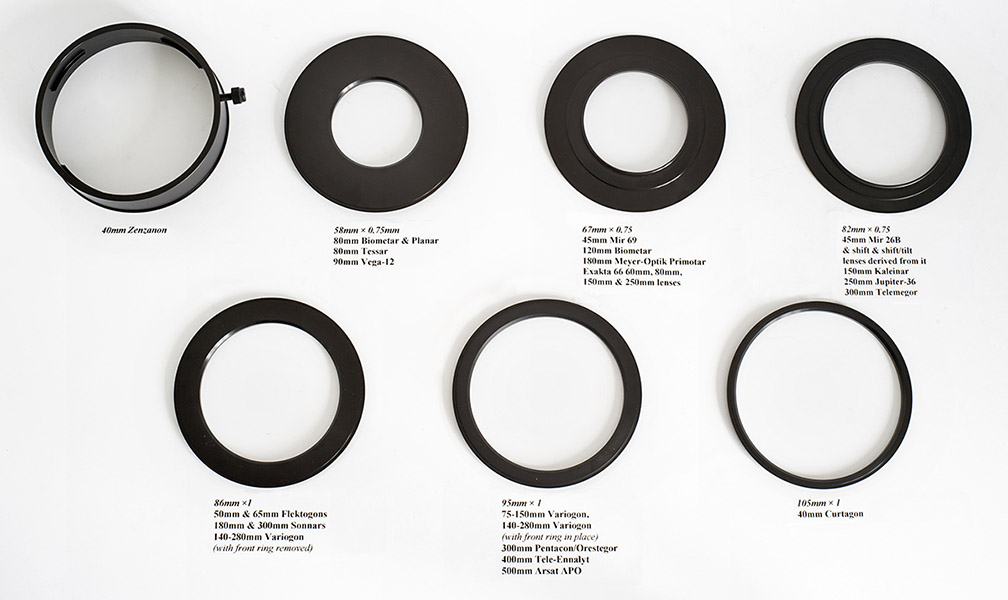by TRA
Filter Systems for Pentacon Six lenses
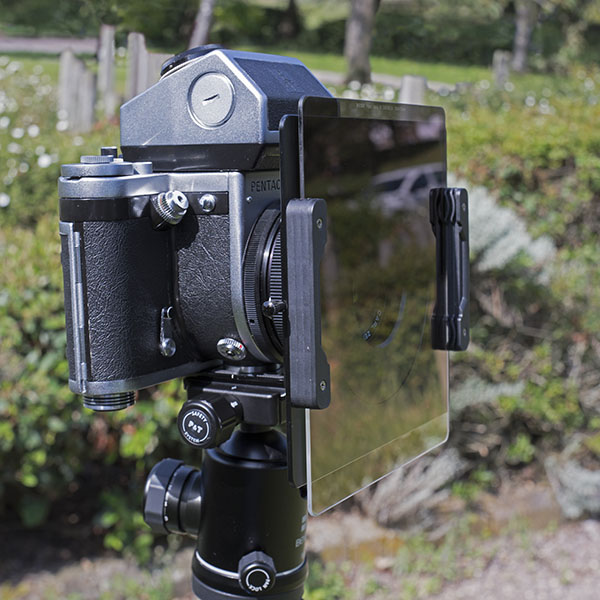
A “square” filter system for the Pentacon Six?
[80mm_Bm_w_grad.jpg]
The Background & The Problem
Traditionally, filters have been round, and they screw into a filter thread on the front of the lens (or many decades ago occasionally were push fit, held in place by friction).
Cokin filters
However, in 1978 the French photographer Jean Coquin introduced a system of square filters. These filters slid into a holder that was mounted onto the lens. Eventually, this system was commercialised world-wide with an anglicised spelling of his name: Cokin. Square (or in some cases rectangular) filters have various advantages:
- They can be mounted via adapter rings onto lenses with different-sized filter mounts.
- Jean Coquin introduced graduated filters, in which the intensity of the filter effect varied from the top of the filter to the bottom. This can be used, for instance, in landscape and seascape photography to reduce the brightness of the sky and avoid over-exposing it.
- The graduated filter can be slid up or
down in the holder, to align with the horizon, which
does not have to be at the mid point of the image,
which is seldom the best position, from a
compositional point of view.
Cokin subsequently introduced two further sizes:
- “Z-Pro” with sizes for lenses with filter mounts up to 96mm diameter
- “X-Pro” with sizes for lenses with filter mounts up to 112mm diameter.
Meanwhile, other manufacturers have entered the same sector of the market.
Lee filters
One of the best-known in the U.K. is Lee filters. At the time of writing, they have information on a 100mm system, which can be accessed here. (Link correct on 29th September 2019). Even this can be too small for some wide-angle lenses, and so Lee have now introduced a 150mm system. They call it “SW150”. I would guess that “SW” stands for “Super-Wide”. Information on that system can currently be accessed here. This certainly sounds fully suitable for Pentacon Six lenses. However, I have no experience of it, having followed another route.
Voigtländer lenses and NiSi filters
A couple of years ago I bought the superb 10mm (!) Voigtländer “Hyper-Wide Heliar” lens. Such an extreme wide-angle lens could not be made even for a 35mm SLR, and it was previously only available for Rangefinder cameras. However, when mirrorless digital cameras were introduced, Voigtländer made this lens available in the Sony FE “35mm full frame” mount. It is of course a superb lens. However, it does not cover 6 × 6 format and cannot be used on a Pentacon Six. But ...
For such an extreme wide-angle lens, one on-line review recommended the NiSi 150mm Filter Holder System, and I bought the holder immediately, in case it was discontinued (which seems to have happened!!).
Here are some pictures of the NiSi holder on the 10mm Voigtländer lens, on a Sony mirrorless full frame 35mm camera:
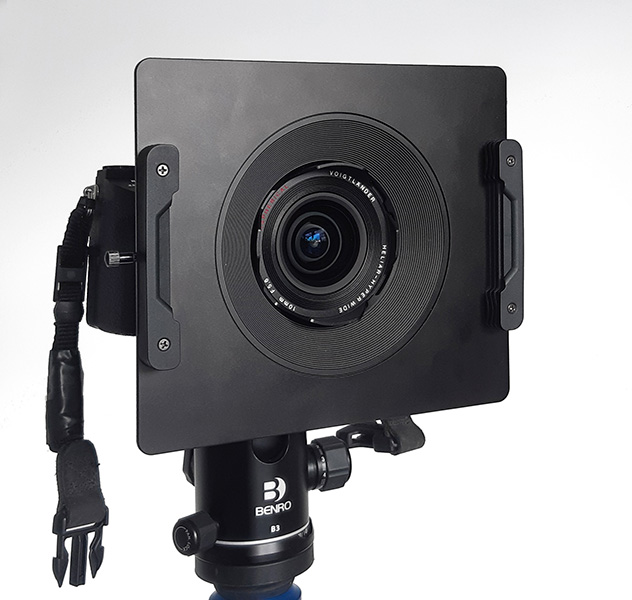 As indicated by the name, this filter holder takes rectangular filters that are 150mm wide. It is shown here and in the picture to the right with no filter in place. [Vgt03.jpg] |
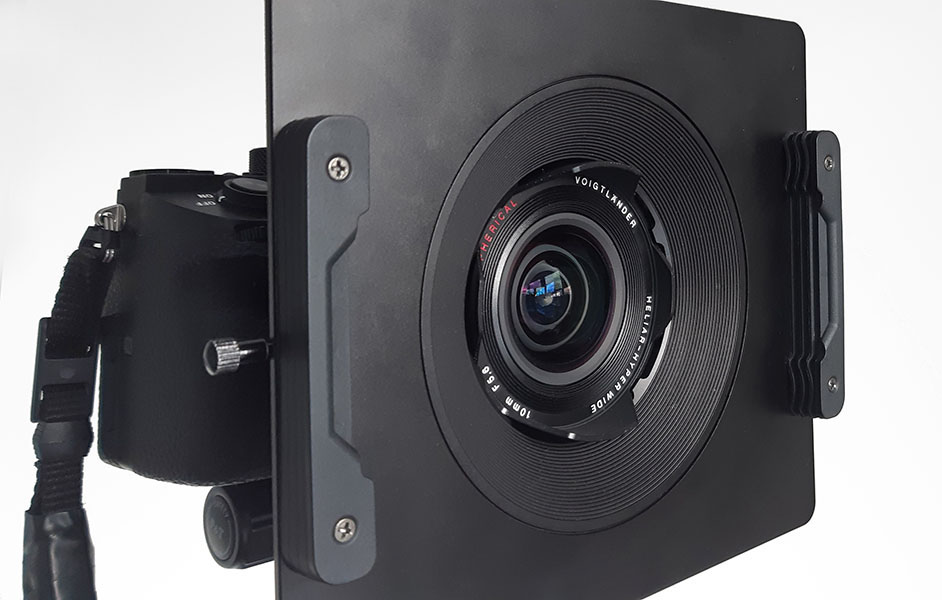 This closer view reveals how the holder is slipped round the petals of the built-in lens hood. The central section of the holder is mildly conical, which has to be the case so that the filters will clear the front of the lens hood petals. [Vgt02.jpg] |
|
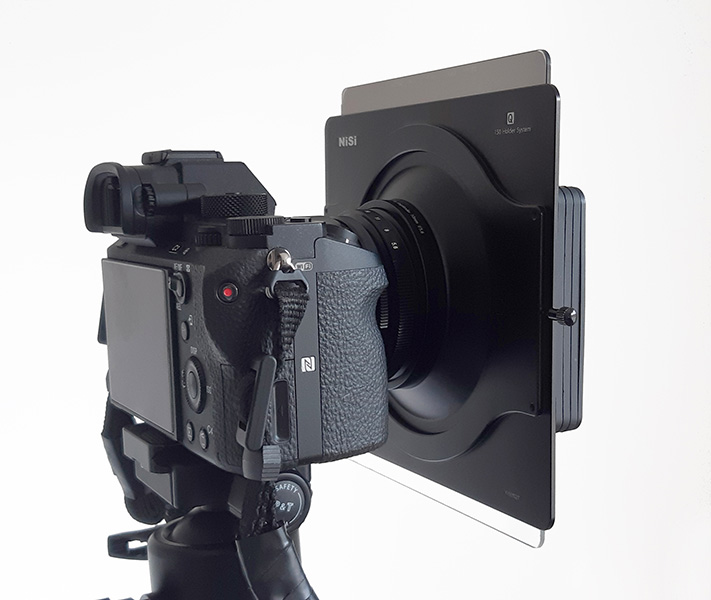 This side view enables us to appreciate how the holder is attached to the lens. Again we can see the conical shape of the inner section of the holder. Here we have inserted a 3-stop hard graduated ND filter into the holder. [Vgt06.jpg] |
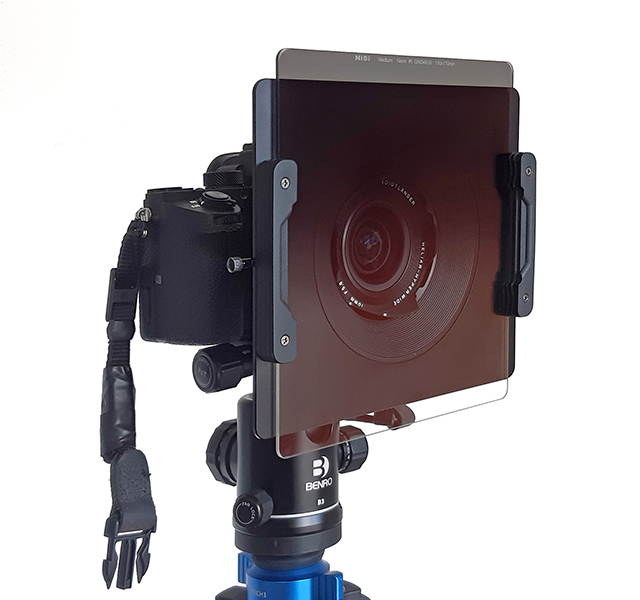 Front view with the graduated filter in place. This is a grey graduated filter. The brownish-reddish colour visible here is the colour that is reflected by the multi-coating on the filter. A totally-neutral grey is what is transmitted by the filter. [Vgt04.jpg] |
|
Note that while most NiSi filters are square, the graduated Neutral Density filters are 150mm wide × 170mm tall, to permit adjustment of the filter to match the height of the horizon (or other transition from light to dark) in the image. |
||
The NiSi holder has
two separate components:
Making the holder in two separate components has two advantages:
|
|
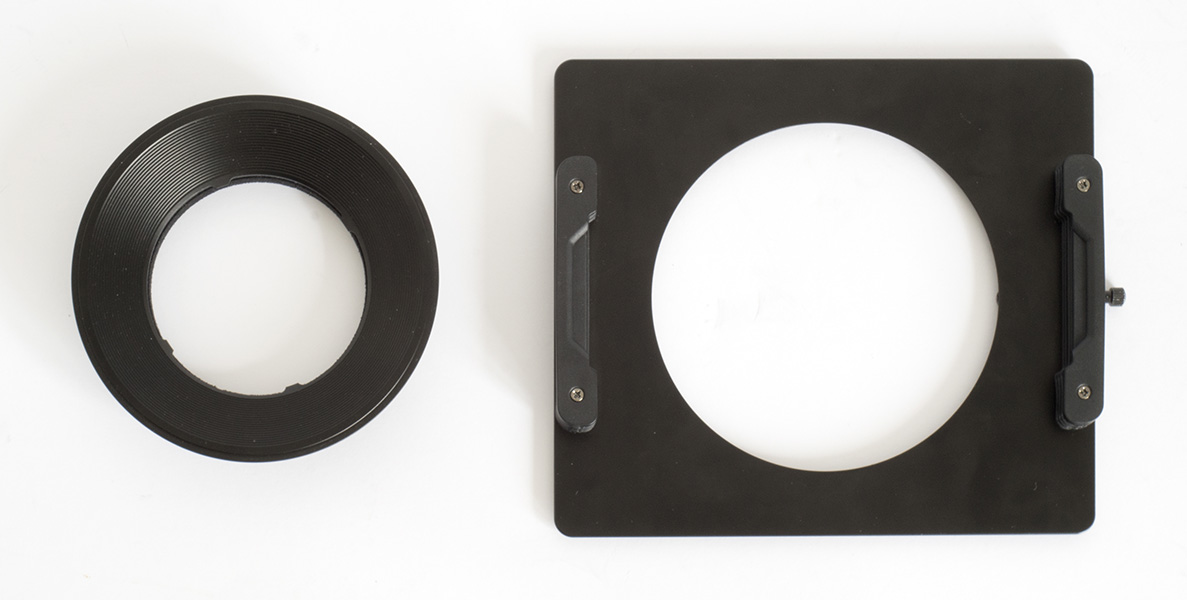 [NiSi_holder.jpg]
|
SRB-Griturn
Regular
visitors to this website may have seen how SRB
have helped me in the past. Their website
is now here.
(Last accessed on 30th September 2019)
I therefore asked them if they could make some custom rings for me. The result can be seen in the image to the right. Because of the petal lens hood of the 40mm Zenzanon lens (see pictures of it here), they had to make a deep ring, which slides onto the petals and has a locking screw to hold it in place. All the other rings are essentially flat discs with a uniform outer diameter and profile to fit into the rectangular component of the NiSi filter holder, and differing internal apertures and filter threads, depending on the lenses for which they are designed. In the picture to the right, the front of the ring is up for the 40mm Zenzanon, 58mm, 86mm, 95mm & 105mm rings, and the back of the ring is up for the 67mm & 82mm rings. Here is a summary of the principal lenses with a Pentacon Six mount that these rings will fit, and some Pentax 67 lenses that will mount on one of my Pentacon Sixes, via a special lens mount ring (see details here), plus a few lenses for other cameras:
|
|
Click on this
image to see it larger.
[SRB_rings_s.jpg] Note that
while SRB-Griturn are always prepared to
consider orders for special, one-off items,
experience has taught them not to produce
bespoke items based on dimensions measured
by customers – or even from specifications
published by other manufacturers! – as these
can be inaccurate. They work to
fractions of a millimeter, and so do their
own measurements of the components to which
custom items are to be attached.
|
||||||||||||
| Step-up rings Other lenses can be catered for by using a larger-sized ring, with a step-up ring from the lens to the ring. For instance, for the Arsenal Vega-28B 120mm lens, which takes 62mm × 0.75 filters, the above 67mm ring could be used via a standard 62mm to 67mm step-up ring. One must only be careful using step-up rings when using wide-angle lenses, as the greater depth of the accessory caused by the step-up ring could result in vignetting. However, this is only really a potential problem with the widest wide-angle lenses, which is why rings of the right diameter for these lenses have been made, to avoid the need for step-up rings in such cases. One exception is the Pentax 67 55mm lens, which has a filter mount diameter of 77mm. A 77mm male to 82mm female step-up ring could have been used with the above SRB 82mm ring, but to avoid any risk of vignetting I have preferred to use a 77mm male up to 95mm female step-up ring, as the extra inner diameter of the SRB 95mm ring means that vignetting is less likely when an adapter ring is used on this wide-angle lens. |
||||||||||||||
Using the NiSi system with the SRB rings on the Pentacon Six
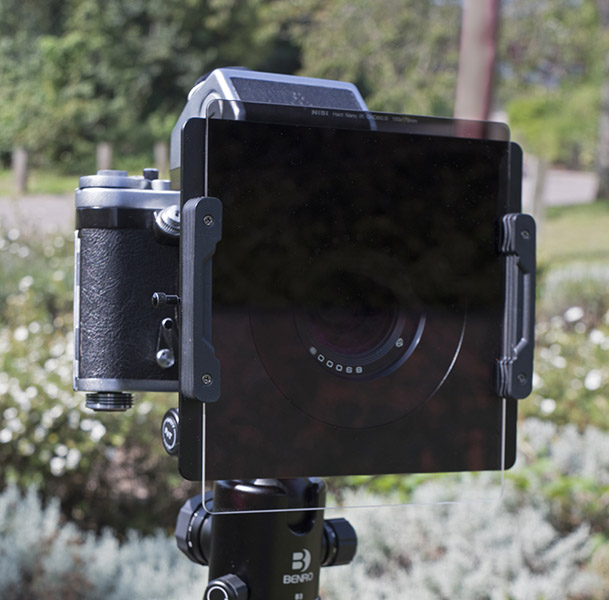 The 45mm Arsenal Mir-69 wide-angle lens with the NiSi filter holder mounted via the SRB 67mm ring, with a NiSi 3-stop hard grad filter in place. [45mmMir69_w_grad.jpg] |
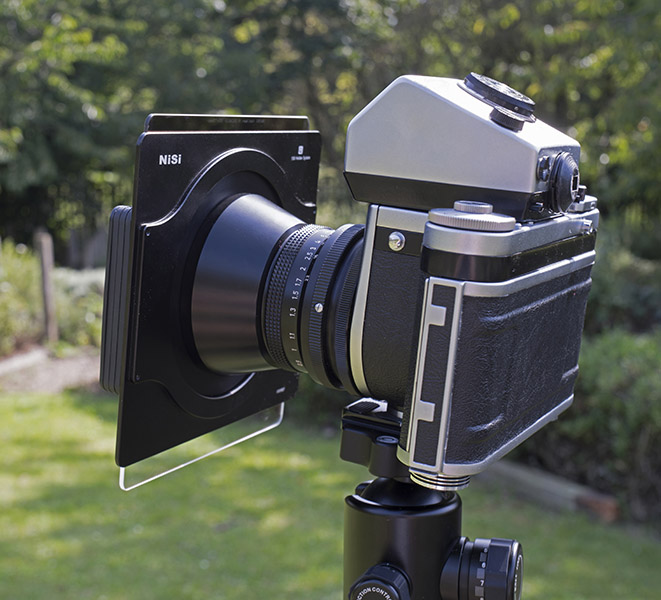 The 50mm Carl Zeiss Jena Flektogon wide-angle lens with the NiSi filter holder mounted via the SRB 86mm ring, with a NiSi 3-stop hard grad filter in place. [50mmFlek_w_grad.jpg] |
|
No
vignetting occurred when using
these combinations of SRB rings and the NiSi
150mm filter holder with these wide-angle
lenses!
|
||
Using filter systems is of course not limited to wide-angle lenses; this system can also be used on standard lenses (as illustrated at the top of this page) and even with long telephoto lenses. In the following pictures we can see the system on a 400mm lens and a 500mm lens.
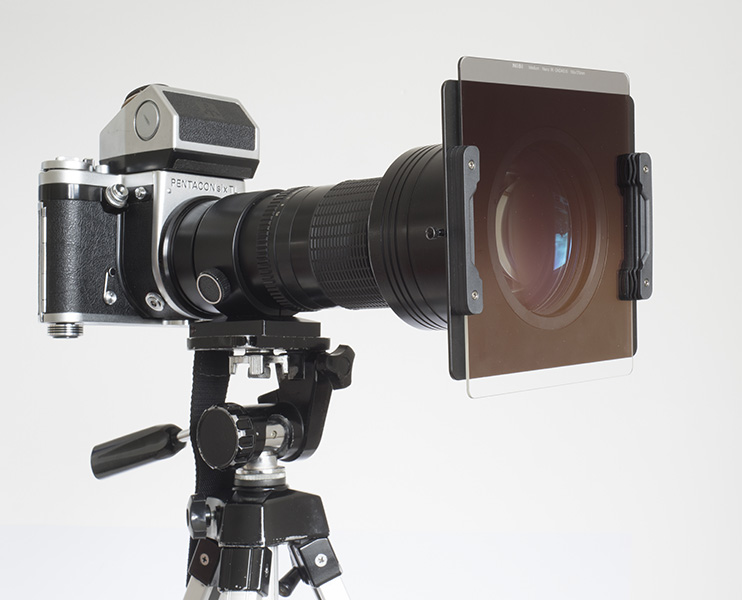 First we can see the filter holder on the Arsat 500mm APO automatic aperture lens, via the SRB 95mm × 1 adapter ring. Here we are using the NiSi two-stop medium grad ND filter. [500APO_NiSi_01.jpg] |
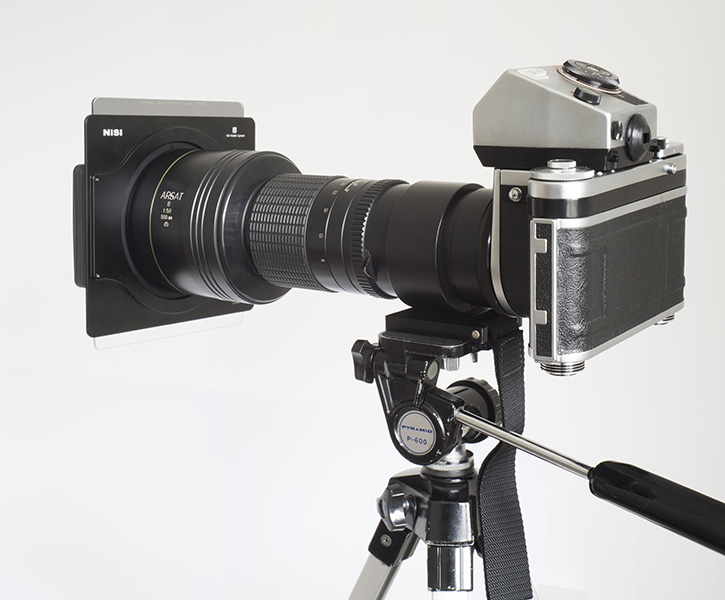 This view enables us to see the integrated lens hood that is permanently mounted on this lens. It is simply slipped fully back in order to accommodate the filter system. More information on this lens can be found here. [500APO_NiSi_02.jpg] |
|
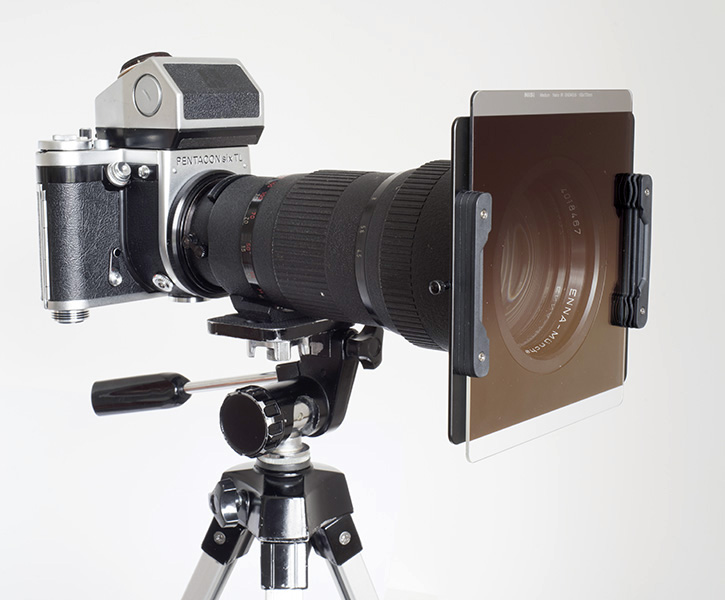 And here we see a super classic lens from the 1960s, the Enna Tele-Ennalyt 400mm lens, again using the same SRB 95mm × 1 adapter ring! Here we have again mounted the NiSi two-stop medium grad ND filter. [400mmEnna_NiSi_01.jpg] |
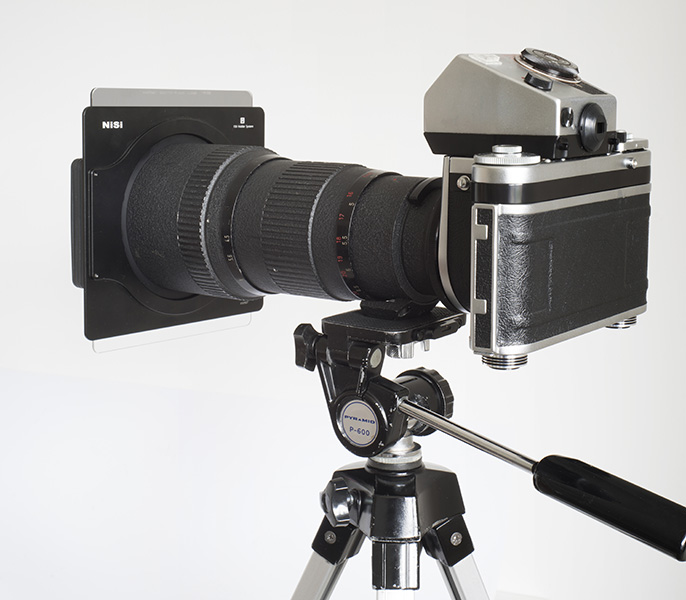 With the Tele-Ennalyt, we have simply unscrewed and removed the standard Enna lens hood. More information on this lens can be found here. [400mmEnna_NiSi_02.jpg] |
Using the NiSi system with the SRB rings on the Exakta 66
The NiSi 150mm filter holder will naturally mount on all the fixed focal length Schneider Kreuznach lenses for the Exakta 66 other than the 40mm Curtagon, as they all have a 67mm × 0.75 filter thread, so here we shall concentrate on the two Schneider Kreuznach zoom lenses, the 75mm-150mm and 140mm-280mm Variogons.
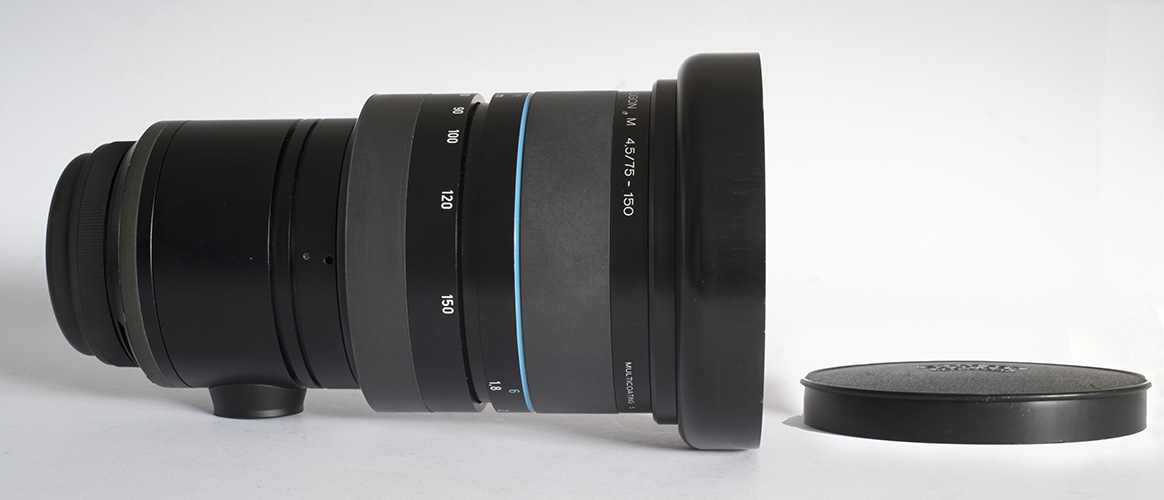 The 75-150mm Variogon M in Exakta 66 style, with its lens hood fitted and the front cap to the right. [75150_01.jpg] |
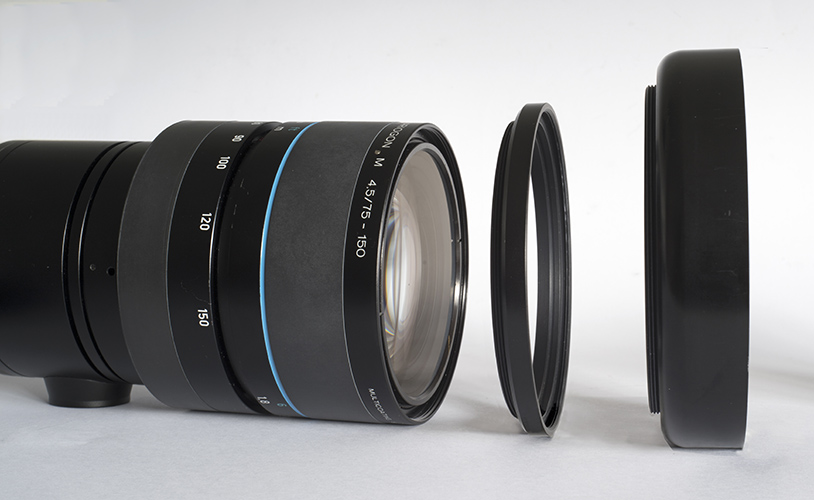 When we remove the lens hood, we find that it has a thread diameter of 100mm, but behind it there is a ring that we can also remove, revealing the 95mm diameter thread on the lens itself. [75150_03.jpg] |
| Here we have mounted
the SRB 95mm × 1 ring onto the front of the
75-150mm Variogon, after removing the ring that
normally goes between the lens and the lens hood. |
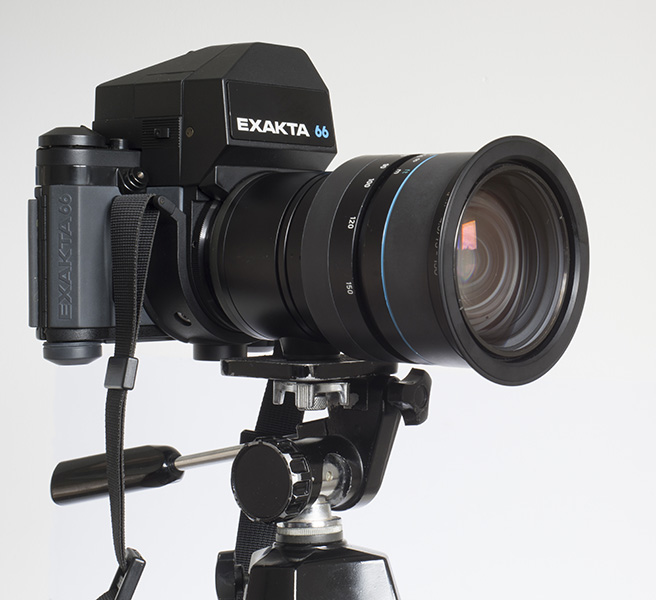 [75150_NiSi_01.jpg] |
|
And here we have
“clipped” the filter holder onto the 95mm ring,
where it is securely held in place by the three
tabs round the edges of the opening in the
holder. We have also put the 2-stop medium
graduated ND filter into the holder. |
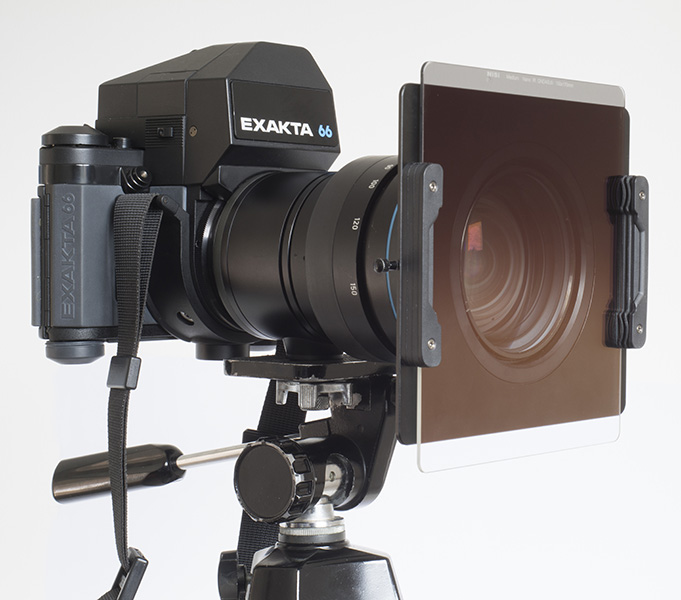 [75150_NiSi_02.jpg] |
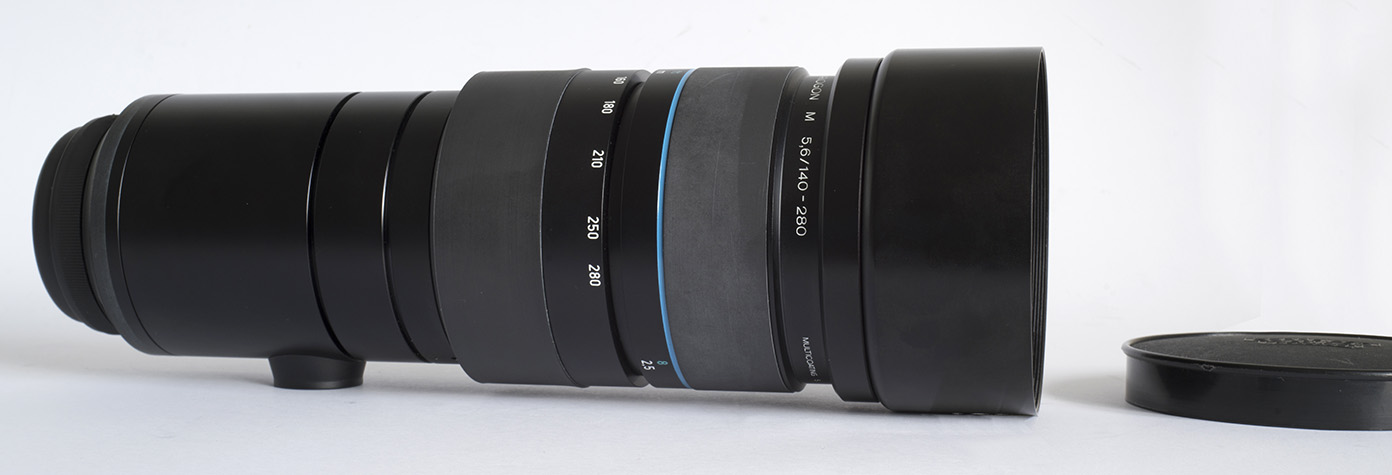 The 140-280mm Variogon M in Exakta 66 style, with its lens hood fitted and the front cap to the right. [140280_01.jpg] |
 When we remove the lens hood, we find that it has a thread diameter of 95mm, but behind it there is a ring that we can also remove, revealing the 86mm diameter thread on the lens itself. [140280_03.jpg] |
|
So with
the longer Variogon we have two filter-mounting
options:
|
||
| Here we have mounted the SRB 86mm × 1 ring onto the front of the 140-280mm Variogon, after removing the ring that normally goes between the lens and the lens hood. | 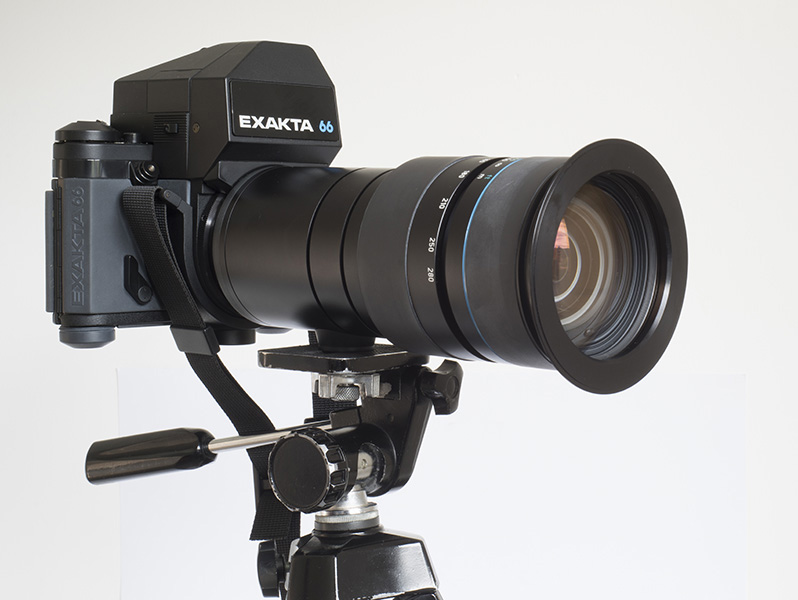 [140280_NiSi_86_02.jpg] |
|
And here we have “clipped” the filter holder onto the 86mm ring, where it is securely held in place by the three tabs round the edges of the opening in the holder. We also have the 2-stop medium graduated ND filter in the holder – in fact, we saved time by merely unclipping the holder from the 95mm ring that we were using with the 75-150mm Variogon. | 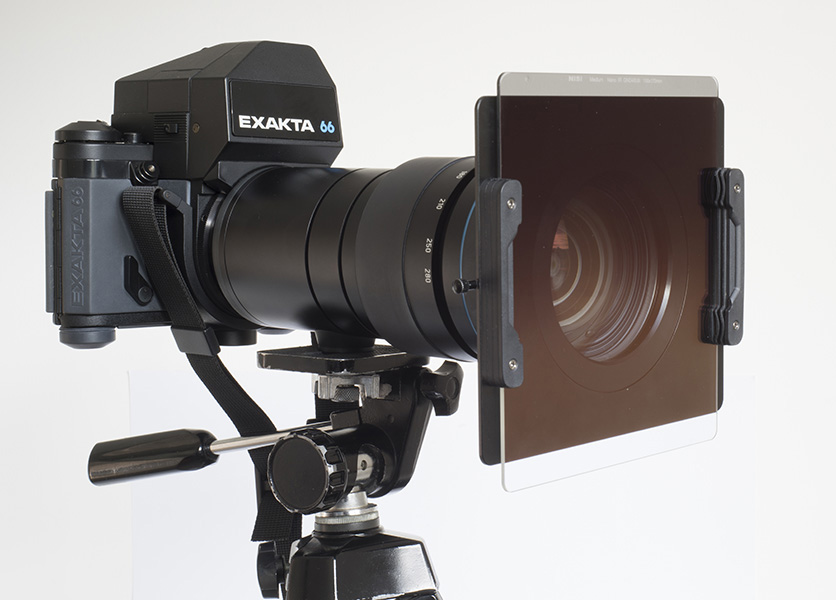 [140280_NiSi_86_01.jpg] |
| Here we have left in
place the 86mm to 95mm ring that sits between the
lens mount and the lens hood, so we have been able
to add the very same 95mm × 1 ring from SRB that
we had used on the 75-150mm Variogon. |
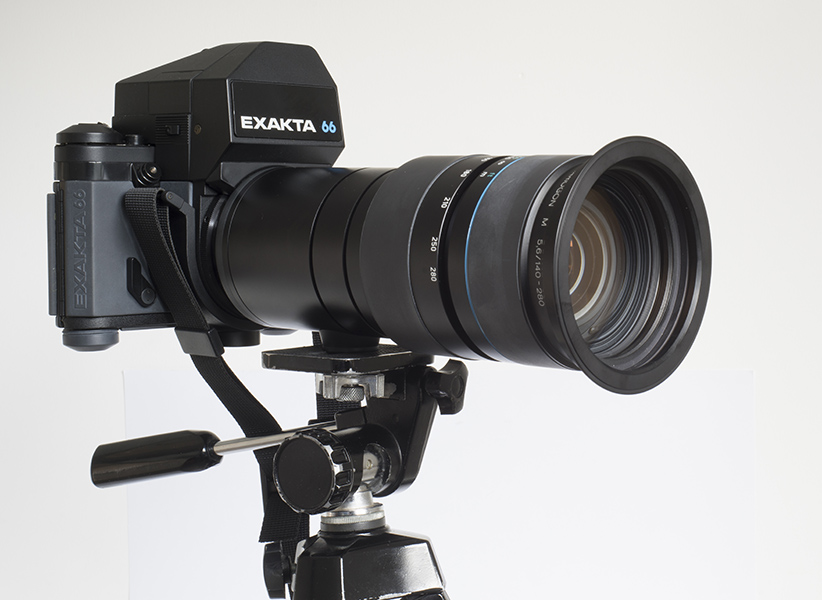 [140280_NiSi_95_01.jpg] |
|
And here we have “clipped” the filter holder onto the 95mm ring, where it is securely held in place by the three tabs round the edges of the opening in the holder. We again have the 2-stop medium graduated ND filter in the holder. With a wide-angle lens we would not want to “stack” rings in this way, because of the danger of vignetting being introduced, but with a lens that has as long a focal length as this, and a filter holder that is so wide, there is no risk of vignetting occurring. | 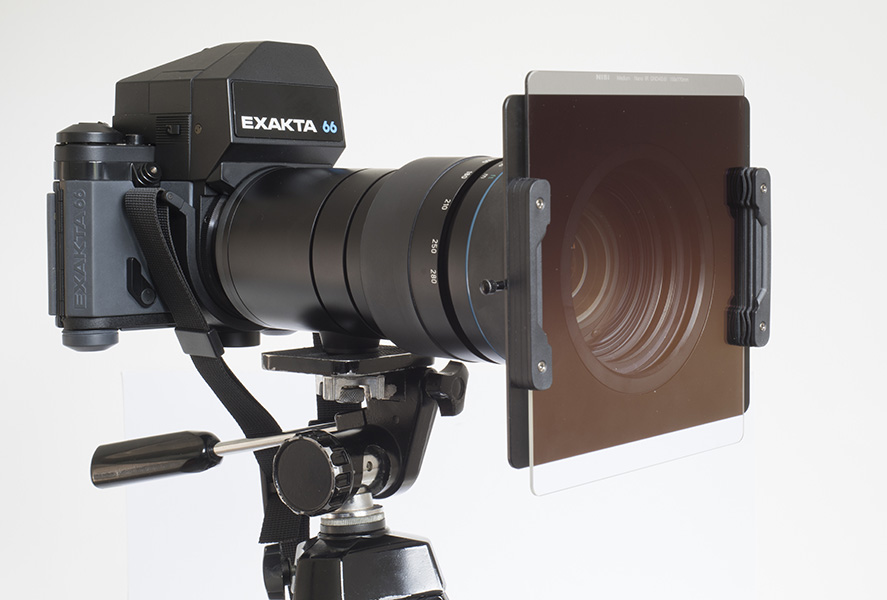 [140280_NiSi_95_02.jpg] |
The first test shots have been taken, but we may need to wait until next spring or summer before shooting seascapes with this system, as the coast is at some distance from here.
